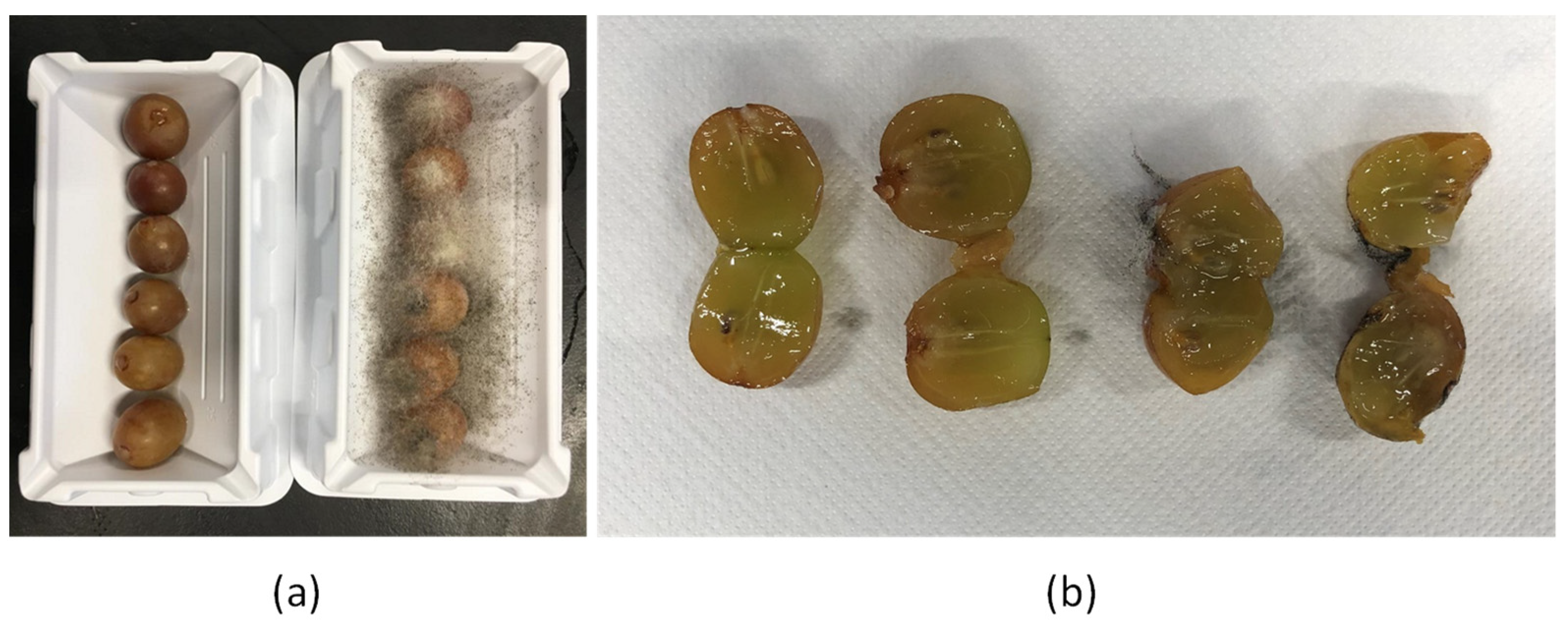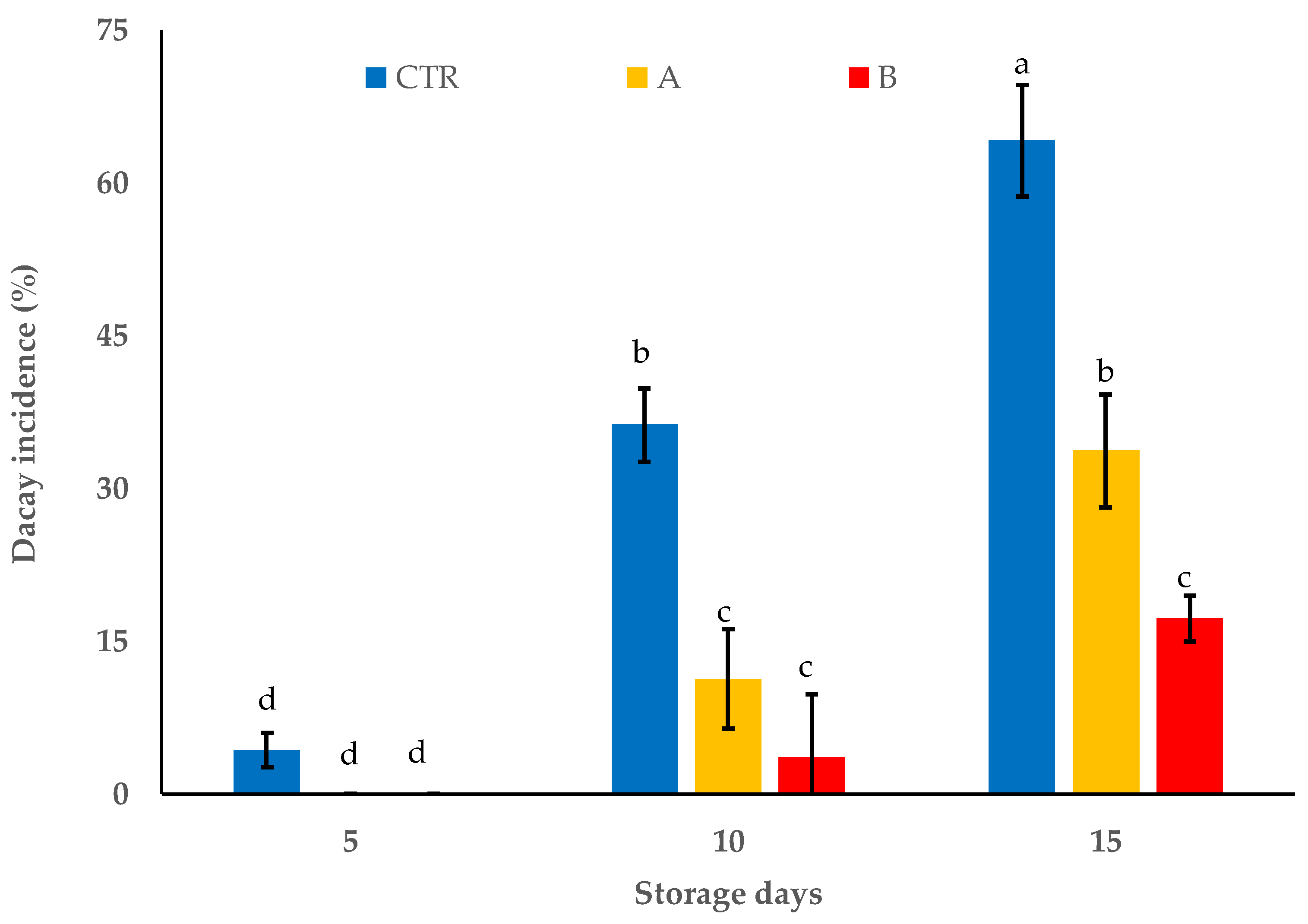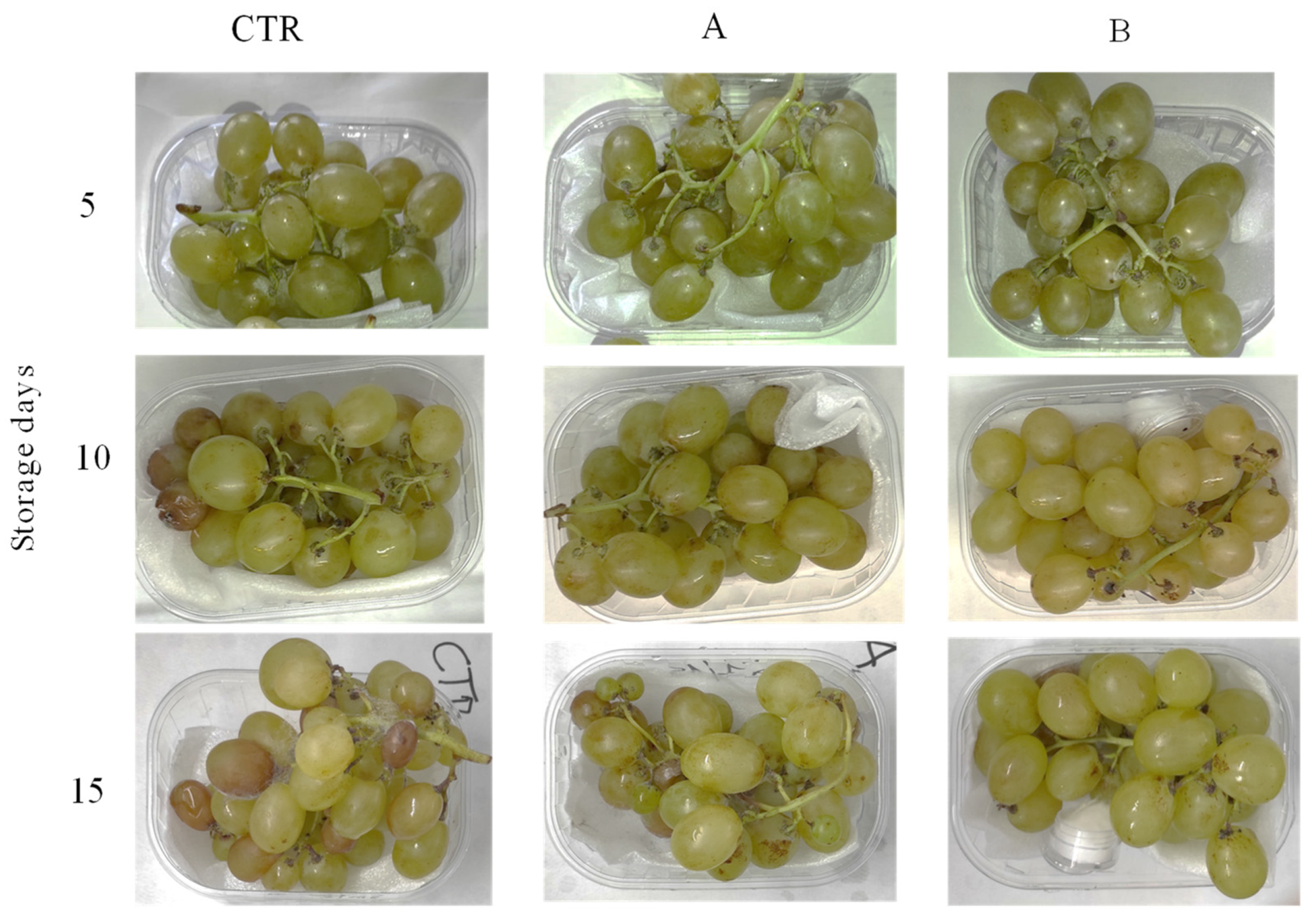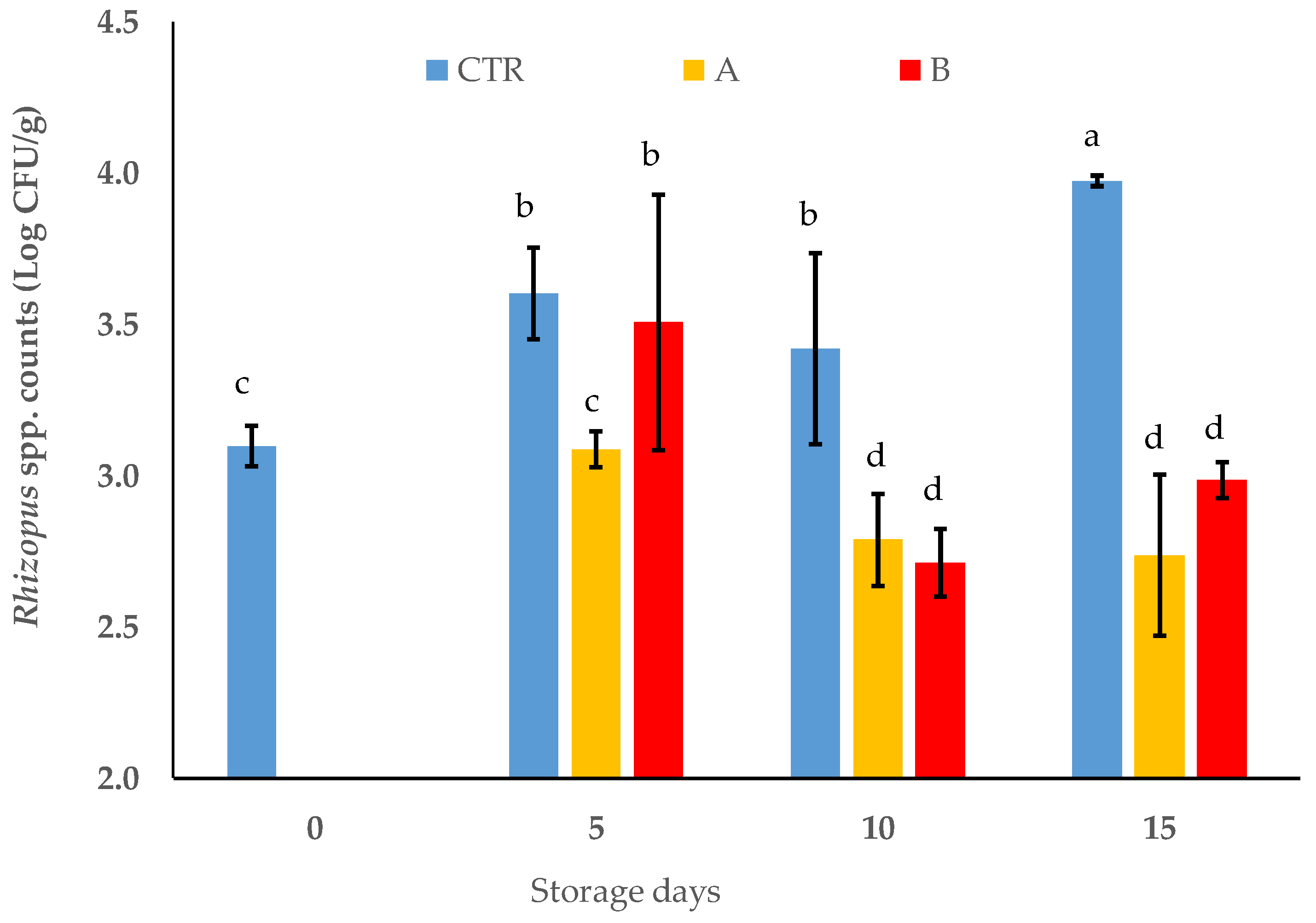Effect of Gaseous Citral on Table Grapes Contaminated by Rhizopus oryzae ITEM 18876
Abstract
:1. Introduction
2. Materials and Methods
2.1. Chemicals and Reagent
2.2. Culture Conditions
2.3. In Vitro Antimicrobial Activity and Minimal Inhibitory Concentration (MIC) Determination
2.4. Antimicrobial Activity of Gaseous Citral on Inoculated Table Grape Berries
2.5. Post-harvest Evaluation of Table Grapes under Citral Treatment
2.5.1. Sample Packaging and Storage
2.5.2. Decay Incidence Determination
2.5.3. Visual Quality and Perception of Citral Odor
2.5.4. Determination of Citral by GC-MS Analysis
2.5.5. Microbiological Analysis
2.6. Statistical Analysis
3. Results and Discussion
3.1. In Vitro Antimicrobial Assay
3.2. Antimicrobial Activity of Gaseous Citral in Food Matrix
3.3. Post-Harvest Evaluation of Citral-Treated Table Grapes during Storage
4. Conclusions
Supplementary Materials
Author Contributions
Funding
Data Availability Statement
Acknowledgments
Conflicts of Interest
References
- Pinto, L.; Caputo, L.; Quintieri, L.; de Candia, S.; Baruzzi, F. Efficacy of gaseous ozone to counteract postharvest table grape sour rot. Food Microbiol. 2017, 66, 190–198. [Google Scholar] [CrossRef] [PubMed]
- Rooney-Latham, S.; Janousek, C.N.; Eskalen, A.; Gubler, W.D. First Report of Aspergillus carbonarius Causing Sour Rot of Table Grapes (Vitis vinifera) in California. Plant Dis. 2008, 92, 651. [Google Scholar] [CrossRef] [PubMed]
- Zoffoli, J.P.; Latorre, B.A. Table grape (Vitis vinifera L.). In Postharvest Biology and Technology of Tropical and Subtropical Fruits; Yahia, E.M., Ed.; Woodhead Publishing: Cambridge, UK, 2011; pp. 179–214e. [Google Scholar]
- Sonker, N.; Pandey, A.K.; Singh, P. Strategies to control post-harvest diseases of table grape: A review. J. Wine Res. 2016, 27, 105–122. [Google Scholar] [CrossRef]
- Bettiga, L.J. Grape Pest Management, 3rd ed; UCANR Publications: Oakland CA, USA, 2013. [Google Scholar]
- Xiao, X.; He, Q.; Li, Z.; Antoce, A.O.; Zhang, X. Improving traceability and transparency of table grapes cold chain logistics by integrating WSN and correlation analysis. Food Control 2017, 73, 1556–1563. [Google Scholar] [CrossRef]
- Lim, M.K.; Li, Y.; Wang, C.; Tseng, M.-L. Prediction of cold chain logistics temperature using a novel hybrid model based on the mayfly algorithm and extreme learning machine. Ind. Manag. Data Syst. 2022, 122, 819–840. [Google Scholar] [CrossRef]
- Mari, M.; Di Francesco, A.; Bertolini, P. Control of fruit postharvest diseases: Old issues and innovative approaches. Stewart Postharvest Rev. 2014, 10, 1–4. [Google Scholar] [CrossRef]
- Bautista-Baños, S.; Bosquez-Molina, E.; Barrera-Necha, L.L. Rhizopus stolonifer (Soft Rot). In Postharvest Decay: Control Strategies; Bautista-Baños, S., Ed.; Elsevier Inc: Amsterdam, The Netherlands, 2014; pp. 1–44. [Google Scholar]
- Rotolo, C.; De Miccolis Angelini, R.M.; Dongiovanni, C.; Pollastro, S.; Fumarola, G.; Di Carolo, M.; Perrelli, D.; Natale, P.; Faretra, F. Use of biocontrol agents and botanicals in integrated management of Botrytis cinerea in table grape vineyards. Pest Manag. Sci. 2018, 74, 715–725. [Google Scholar] [CrossRef]
- Crisosto, C.H.; Crisosto, G.M. Understanding American and Chinese consumer acceptance of ‘Redglobe’table grapes. Postharvest. Biol. Technol. 2002, 24, 155–162. [Google Scholar] [CrossRef]
- European Commission. European Commission Regulation (EU) No 1129/2011 amending Annex II to Regulation (EC) No 1333/2008 of the European Parliament and of the Council by establishing a Union list of food additives. Off. J. Eur. Union. 2011. [Google Scholar]
- Pace, B.; Cefola, M. Innovative Preservation Technology for the Fresh Fruit and Vegetables. Foods 2021, 10, 719. [Google Scholar] [CrossRef]
- De Simone, N.; Pace, B.; Grieco, F.; Chimienti, M.; Tyibilika, V.; Santoro, V.; Capozzi, V.; Colelli, G.; Spano, G.; Russo, P. Botrytis cinerea and Table Grapes: A Review of the Main Physical, Chemical, and Bio-Based Control Treatments in Post-Harvest. Foods 2020, 9, 1138. [Google Scholar] [CrossRef]
- Gorrasi, G.; Bugatti, V.; Vertuccio, L.; Vittoria, V.; Pace, B.; Cefola, M.; Quintieri, L.; Bernardo, P.; Clarizia, G. Active packaging for table grapes: Evaluation of antimicrobial performances of packaging for shelf life of the grapes under thermal stress. Food Packag. Shelf Life 2020, 25, 100545. [Google Scholar] [CrossRef]
- Bugatti, V.; Cefola, M.; Montemurro, N.; Palumbo, M.; Quintieri, L.; Pace, B.; Gorrasi, G. Combined Effect of Active Packaging of Polyethylene Filled with a Nano-Carrier of Salicylate and Modified Atmosphere to Improve the Shelf Life of Fresh Blueberries. Nanomaterials 2020, 10, 2513. [Google Scholar] [CrossRef] [PubMed]
- Quintieri, L.; Bugatti, V.; Caputo, L.; Vertuccio, L.; Gorrasi, G. A Food-Grade Resin with LDH–Salicylate to Extend Mozzarella Cheese Shelf Life. Processes 2021, 9, 884. [Google Scholar] [CrossRef]
- Caputo, L.; Quintieri, L.; Bugatti, V.; Gorrasi, G. A salicylate-functionalized PET packaging to counteract blue discoloration on mozzarella cheese under cold storage. Food Packag. Shelf Life 2022, 32, 100850. [Google Scholar] [CrossRef]
- Falleh, H.; Ben Jemaa, M.; Saada, M.; Ksouri, R. Essential oils: A promising eco-friendly food preservative. Food Chem. 2020, 330, 127268. [Google Scholar] [CrossRef] [PubMed]
- Yeshi, K.; Wangchuk, P. Essential oils and their bioactive molecules in healthcare. In Herbal Biomolecules in Healthcare Applications; Mandal, S.C., Nayak, A.K., Dhara, A.K., Eds.; Academic Press: Cambridge, MA, USA, 2022; pp. 215–237. [Google Scholar]
- Souza, V.V.M.A.; Almeida, J.M.; Barbosa, L.N.; Silva, N.C.C. Citral, carvacrol, eugenol and thymol: Antimicrobial activity and its application in food. J. Essent. Oil Res. 2022, 34, 181–194. [Google Scholar] [CrossRef]
- Ganjewala, D.; Gupta, A.K.; Muhury, R. An Update on Bioactive Potential of a Monoterpene Aldehyde Citral. J. Biol. Act. Prod. Nat. 2012, 2, 186–199. [Google Scholar] [CrossRef]
- Implementing Regulation 2012/872—List of Flavouring Substances Provided for by Regulation 2232/96, Introducing it in Annex I to Regulation 1334/2008. Available online: https://www.eumonitor.eu/9353000/1/j4nvk6yhcbpeywk_j9vvik7m1c3gyxp/vj3i7x7drxy4 (accessed on 3 May 2022).
- Commission Implementing Regulation (EU) 2020/1396 of 5 October 2020 Concerning the Authorisation of Geraniol, Citral, 3,7,11-Trimethyldodeca-2,6,10-Trien-1-Ol, (Z)-Nerol, Geranyl Acetate, Geranyl Butyrate, Geranyl Formate, Geranyl Propionate, Neryl Propionate, Neryl Formate, Neryl Acetate, Neryl Isobutyrate, Geranyl Isobutyrate and Prenyl Acetate as Feed Additives for All Animal Species Except for Marine Animals. Available online: https://www.legislation.gov.uk/eur/2020/1396/2020-12-31?view=plain (accessed on 3 May 2022).
- Fancello, F.; Petretto, G.L.; Marceddu, S.; Venditti, T.; Pintore, G.; Zara, G.; Mannazzu, I.; Budroni, M.; Zara, S. Antimicrobial activity of gaseous Citrus limon var pompia leaf essential oil against Listeria monocytogenes on ricotta salata cheese. Food Microbiol. 2020, 87, 103386. [Google Scholar] [CrossRef]
- Mangalagiri, N.P.; Panditi, S.K.; Jeevigunta, N.L.L. Antimicrobial activity of essential plant oils and their major components. Heliyon 2021, 7, e06835. [Google Scholar] [CrossRef]
- Thielmann, J.; Theobald, M.; Wutz, A.; Krolo, T.; Buergy, A.; Niederhofer, J.; Welle, F.; Muranyi, P. Litsea cubeba fruit essential oil and its major constituent citral as volatile agents in an antimicrobial packaging material. Food Microbiol. 2021, 96, 103725. [Google Scholar] [CrossRef]
- Pedrotti, C.; Marcon, R.; Delamare, A.P.L.; Echeverrigaray, S.; Ribeiro, R.T.D.S.; Schwambach, J. Alternative control of grape rots by essential oils of two Eucalyptus species. J. Sci. Food Agric. 2019, 99, 6552–6561. [Google Scholar] [CrossRef] [PubMed]
- Oh, Y.A.; Oh, Y.J.; Song, A.Y.; Won, J.S.; Bin Song, K.; Min, S.C. Comparison of effectiveness of edible coatings using emulsions containing lemongrass oil of different size droplets on grape berry safety and preservation. LWT 2017, 75, 742–750. [Google Scholar] [CrossRef]
- Nedorostova, L.; Kloucek, P.; Kokoska, L.; Stolcova, M.; Pulkrabek, J. Antimicrobial properties of selected essential oils in vapour phase against foodborne bacteria. Food Control 2009, 20, 157–160. [Google Scholar] [CrossRef]
- Guerra, I.C.D.; de Oliveira, P.D.L.; Fernandes-Santos, M.M.; Lúcio, A.S.S.C.; Tavares, J.F.; Barbosa-Filho, J.M.; Madruga, M.S.; de Souza, E.L. The effects of composite coatings containing chitosan and Mentha (piperita L. or x villosa Huds) essential oil on postharvest mold occurrence and quality of table grape cv. Isabella. Innov. Food Sci. Emerg. Technol. 2016, 34, 112–121. [Google Scholar] [CrossRef]
- Youssef, K.; Roberto, S.R. Applications of salt solutions before and after harvest affect the quality and incidence of postharvest gray mold of ‘Italia’ table grapes. Postharvest Biol. Technol. 2014, 87, 95–102. [Google Scholar] [CrossRef]
- Eppo, C. European and mediterranean plant protection organization. Bull. OEPP/EPPO Bull. 1997, 27, 643–644. Available online: http://pp1.eppo.int/list.php (accessed on 10 April 2022).
- Cefola, M.; Damascelli, A.; Lippolis, V.; Cervellieri, S.; Linsalata, V.; Logrieco, A.F.; Pace, B. Relationships among volatile metabolites, quality and sensory parameters of ‘Italia’ table grapes assessed during cold storage in low or high CO 2 modified atmospheres. Postharvest Biol. Technol. 2018, 142, 124–134. [Google Scholar] [CrossRef]
- D’Acampora Zellner, B.; Bicchi, C.; Dugo, P.; Rubiolo, P.; Dugo, G.; Mondello, L. Linear retention indices in gas chromatographic analysis: A review. Flavour Fragr. J. 2008, 23, 297–314. [Google Scholar] [CrossRef]
- National Institute of Standard and Technology. Available online: www.nist.gov (accessed on 28 June 2022).
- Saddiq, A.A.; Khayyat, S. Chemical and antimicrobial studies of monoterpene: Citral. Pestic. Biochem. Physiol. 2010, 98, 89–93. [Google Scholar] [CrossRef]
- Zhou, L.; Zhang, Z.; Wei, M.; Xie, Y.; He, S.; Shi, H.; Lin, Z. Evaluation of the antifungal activity of individual and combined monoterpenes against Rhizopus stolonifer and Absidia coerulea. Environ. Sci. Pollut. Res. 2019, 26, 7804–7809. [Google Scholar] [CrossRef] [PubMed]
- Ouyang, Q.; Tao, N.; Jing, G. Transcriptional profiling analysis of Penicillium digitatum, the causal agent of citrus green mold, unravels an inhibited ergosterol biosynthesis pathway in response to citral. BMC Genom. 2016, 17, 1–16. [Google Scholar] [CrossRef] [PubMed]
- Ma, H.; Zhao, Y.; Lu, Z.; Xing, R.; Yao, X.; Jin, Z.; Wang, Y.; Yu, F. Citral-loaded chitosan/carboxymethyl cellulose copolymer hydrogel microspheres with improved antimicrobial effects for plant protection. Int. J. Biol. Macromol. 2020, 164, 986–993. [Google Scholar] [CrossRef] [PubMed]
- Muriel-Galet, V.; Cerisuelo, J.P.; López-Carballo, G.; Aucejo, S.; Gavara, R.; Hernández-Muñoz, P. Evaluation of EVOH-coated PP films with oregano essential oil and citral to improve the shelf-life of packaged salad. Food Control 2013, 30, 137–143. [Google Scholar] [CrossRef]
- Siracusa, V.; Romani, S.; Gigli, M.; Mannozzi, C.; Cecchini, J.P.; Tylewicz, U.; Lotti, N. Characterization of Active Edible Films based on Citral Essential Oil, Alginate and Pectin. Materials 2018, 11, 1980. [Google Scholar] [CrossRef]
- Sarfraz, J.; Hansen, A.; Haugen, J.-E.; Le, T.-A.; Nilsen, J.; Skaret, J.; Huynh, T.; Pettersen, M. Biodegradable Active Packaging as an Alternative to Conventional Packaging: A Case Study with Chicken Fillets. Foods 2021, 10, 1126. [Google Scholar] [CrossRef]
- Laorenza, Y.; Harnkarnsujarit, N. Carvacrol, citral and α-terpineol essential oil incorporated biodegradable films for functional active packaging of Pacific white shrimp. Food Chem. 2021, 363, 130252. [Google Scholar] [CrossRef]
- Yoplac, I.; Vargas, L.; Robert, P.; Hidalgo, A. Characterization and antimicrobial activity of microencapsulated citral with dextrin by spray drying. Heliyon 2021, 7, e06737. [Google Scholar] [CrossRef]
- Hamishehkar, H.; MokariZadeh, M.; Kafil, H.S.; Ghanbarzadeh, S.; Alizadeh, A. Improvement of citral antimicrobial activity by incorporation into nanostructured lipid carriers: A potential application in food stuffs as a natural preservative. Res. Pharm. Sci. 2017, 12, 409–415. [Google Scholar] [CrossRef]
- Han, J.H. Antimicrobial Food Packaging. In Novel Food Packaging Techniques; Ahvenainen, R., Ed.; CRC Press: New York, NY, USA, 2003; pp. 50–70. [Google Scholar]
- Lucera, A.; Conte, A.; Del Nobile, M.A. Volatile Compounds Usage in Active Packaging Systems. In Antimicrobial Food Packaging; Barros-Velázquez, J., Ed.; Academic Press: San Diego, CA, USA, 2016; pp. 319–327. [Google Scholar] [CrossRef]
- Tao, N.; OuYang, Q.; Jia, L. Citral inhibits mycelial growth of Penicillium italicum by a membrane damage mechanism. Food Control 2014, 41, 116–121. [Google Scholar] [CrossRef]
- Ress, N.B.; Hailey, J.R.; Maronpot, R.R.; Bucher, J.R.; Travlos, G.S.; Haseman, J.K.; Orzech, D.P.; Johnson, J.D.; Hejtmancik, M.R. Toxicology and Carcinogenesis Studies of Microencapsulated Citral in Rats and Mice. Toxicol. Sci. 2003, 71, 198–206. [Google Scholar] [CrossRef] [PubMed]
- Hellín, P.; Manso, A.; Flores, P.; Fenoll, J. Evolution of Aroma and Phenolic Compounds during Ripening of ’Superior Seedless’ Grapes. J. Agric. Food Chem. 2010, 58, 6334–6340. [Google Scholar] [CrossRef] [PubMed]
- Guerreiro, A.C.; Gago, C.M.; Miguel, M.G.; Faleiro, M.L.; Antunes, M.D. The influence of edible coatings enriched with citral and eugenol on the raspberry storage ability, nutritional and sensory quality. Food Packag. Shelf Life 2016, 9, 20–28. [Google Scholar] [CrossRef]
- Guerreiro, A.C.; Gago, C.M.L.; Faleiro, M.L.; Miguel, M.G.C.; Antunes, M.D.C. The effect of alginate-based edible coatings enriched with essential oils constituents on Arbutus unedo L. fresh fruit storage. Postharvest Biol. Technol. 2015, 100, 226–233. [Google Scholar] [CrossRef]
- Valero, D.; Valverde, J.; Martínez-Romero, D.; Guillén, F.; Castillo, S.; Serrano, M. The combination of modified atmosphere packaging with eugenol or thymol to maintain quality, safety and functional properties of table grapes. Postharvest Biol. Technol. 2006, 41, 317–327. [Google Scholar] [CrossRef]
- Wei, L.; Chen, C.; Chen, J.; Lin, L.; Wan, C. Possible fungicidal effect of citral on kiwifruit pathogens and their mechanisms of actions. Physiol. Mol. Plant Pathol. 2021, 114, 101631. [Google Scholar] [CrossRef]
- Valverde, J.M.; Guillen, F.; Martínez-Romero, D.; Castillo, S.; Serrano, A.M.; Valero, D. Improvement of Table Grapes Quality and Safety by the Combination of Modified Atmosphere Packaging (MAP) and Eugenol, Menthol, or Thymol. J. Agric. Food Chem. 2005, 53, 7458–7464. [Google Scholar] [CrossRef]
- Boukhatem, M.N.; Ferhat, M.A.; Rajabi, M.; Mousa, S.A. Solvent-free microwave extraction: An eco-friendly and rapid process for green isolation of essential oil from lemongrass. Nat. Prod. Res. 2022, 36, 664–667. [Google Scholar] [CrossRef]
- Rodrigues, L.; Coelho, E.; Madeira, R.; Teixeira, P.; Henriques, I.; Coimbra, M.A. Food Ingredients Derived from Lemongrass Byproduct Hydrodistillation: Essential Oil, Hydrolate, and Decoction. Molecules 2022, 27, 2493. [Google Scholar] [CrossRef]




Publisher’s Note: MDPI stays neutral with regard to jurisdictional claims in published maps and institutional affiliations. |
© 2022 by the authors. Licensee MDPI, Basel, Switzerland. This article is an open access article distributed under the terms and conditions of the Creative Commons Attribution (CC BY) license (https://creativecommons.org/licenses/by/4.0/).
Share and Cite
Quintieri, L.; Fancello, F.; Caputo, L.; Sorrentino, A.; Zara, S.; Lippolis, V.; Cervellieri, S.; Fanelli, F.; Corvino, A.; Pace, B.; et al. Effect of Gaseous Citral on Table Grapes Contaminated by Rhizopus oryzae ITEM 18876. Foods 2022, 11, 2478. https://doi.org/10.3390/foods11162478
Quintieri L, Fancello F, Caputo L, Sorrentino A, Zara S, Lippolis V, Cervellieri S, Fanelli F, Corvino A, Pace B, et al. Effect of Gaseous Citral on Table Grapes Contaminated by Rhizopus oryzae ITEM 18876. Foods. 2022; 11(16):2478. https://doi.org/10.3390/foods11162478
Chicago/Turabian StyleQuintieri, Laura, Francesco Fancello, Leonardo Caputo, Andrea Sorrentino, Severino Zara, Vincenzo Lippolis, Salvatore Cervellieri, Francesca Fanelli, Antonia Corvino, Bernardo Pace, and et al. 2022. "Effect of Gaseous Citral on Table Grapes Contaminated by Rhizopus oryzae ITEM 18876" Foods 11, no. 16: 2478. https://doi.org/10.3390/foods11162478
APA StyleQuintieri, L., Fancello, F., Caputo, L., Sorrentino, A., Zara, S., Lippolis, V., Cervellieri, S., Fanelli, F., Corvino, A., Pace, B., & Cefola, M. (2022). Effect of Gaseous Citral on Table Grapes Contaminated by Rhizopus oryzae ITEM 18876. Foods, 11(16), 2478. https://doi.org/10.3390/foods11162478











